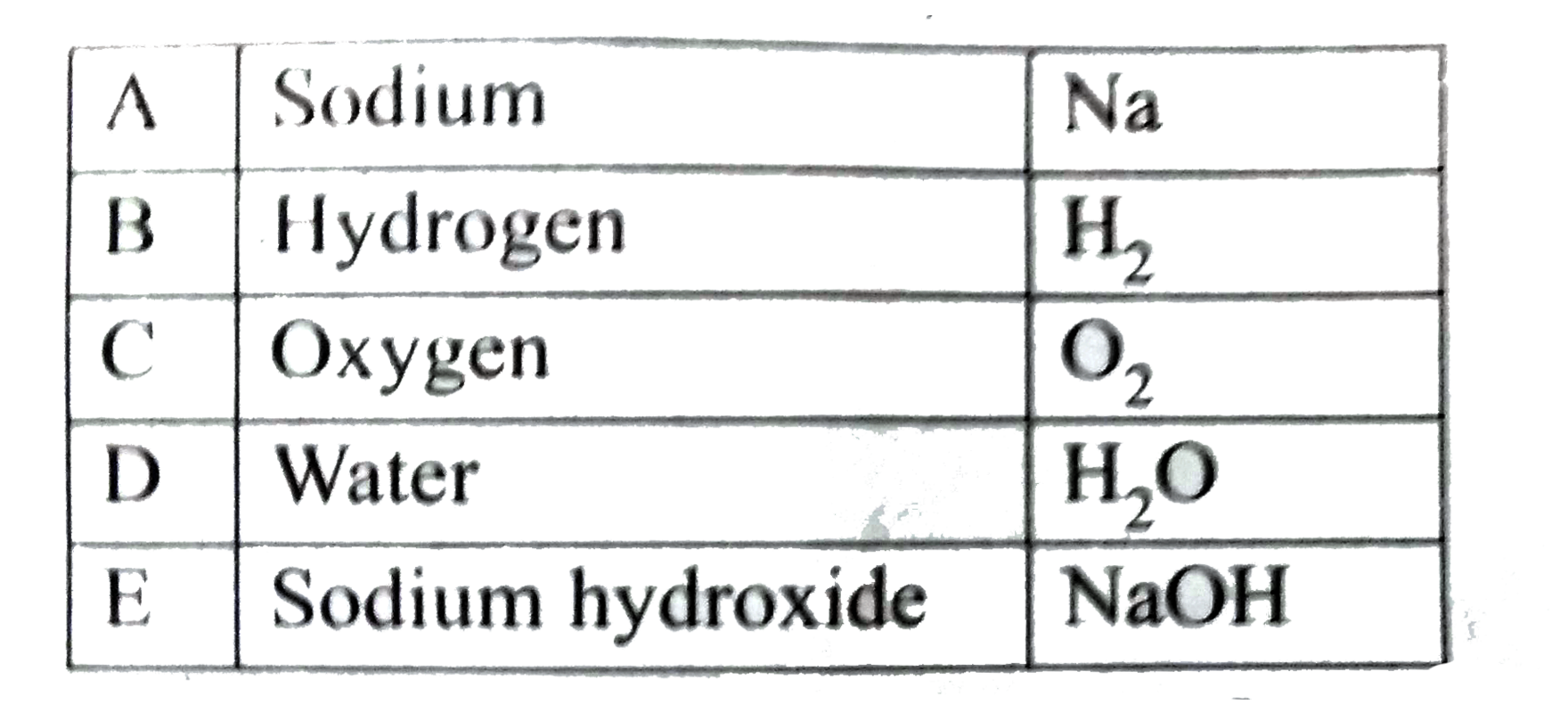A groups metal (A) which is present in common salt reacts with (B) to give compound in which hydrogen is present in -1 oxidation state. (B) on reaction with a gas (C) to i universal solvent (D). The compound (D) on reacts with (A) to give (E), a strong base Identify A, B, C, D and E. Explain the reactions. Solution in Tamil
(i) Group (1) metal (A) is present in common salt NaCl. So, (A) is sodium Na.
(ii) Sodium reacts with hydrogen (B) to give sodium hydride-Nal (C) in which hydrogen is in-1 oxidation state.
2Na+H2→2NaH
Sodium (A) Hydrogen (B) Sodium hydride (C)
(iii) Hydrogen on reaction with oxygen (0,) gas which is (C) to give a universal solvent water(D).
2H2+O2−−→2H2O
Water (iv) Water (D) reacts with sodium metal (A) to give a strong base sodium hydroxide NaOH which is (E).
2Na+2H2O→2NaOH+H2

Topper's Solved these Questions
- HYDROGEN BOOK - FULL MARKSCHAPTER - HYDROGEN EXERCISE - Additional Questions Solved(I. Choose the correct answer)
42 Videos
- HYDROGEN BOOK - FULL MARKSCHAPTER - HYDROGEN EXERCISE - Additional Questions Solved( II. Match the following)
2 Videos
- HYDROGEN BOOK - FULL MARKSCHAPTER - HYDROGEN EXERCISE - Additional Questions Solved 5-Mark Questions
10 Videos
- HYDROCARBONSBOOK - FULL MARKSCHAPTER - HYDROCARBONSEXERCISE - Additional Question Solved (5 mark question )
15 Videos
- PERIODIC CLASSIFICATION OF ELEMENTS BOOK - FULL MARKSCHAPTER - PERIODIC CLASSIFICATION OF ELEMENTS EXERCISE - Activity 3.2
1 Videos
Similar Questions
Which one of the following element mostly present in the sun and the stars?
View SolutionMatch the List-I and List-Il using the correct code given below the list.

View SolutionExplain about the different industrial preparation of hydrogen.
View SolutionExplain the conformation analysis of ethane
View SolutionThe electronegativity for some elements on pauline scale of different groups and periods are listed below. Plot these values against atomic number. From the pattern, explain the variation along a period and a group.
2nd group elements : Be (1.6), Mg (1.2). Ca (1.0), Sr (1.0) Ba(0.9)
17th group elements : F (4.0), CI (3.0), Br (2.8). I (2.5)
3rd Period elements : Na(0.9), Mg(1.2), AI (1.5), Si(1.8), P(2.1), S(2.5), CI(3.0)
4th period elements : K(0.8), Ca(1.0). Sc(1.3), Ti(1.5), V(1.6), Cr(16), Mn(1.5), Fe(1.8). Co(1.9), Ni(1.9). Cu(1.9). Zn(16), Ga(16), Ge(1.8), As(2.0), Se(2.4), Br(2.8)
View SolutionBoron reacts with oxygen at 700^@C to give (A) . Compound (A) reacts with carbon and dry chloride to give (B) and carbon monoxide. (B) on reduction with LiAlH_(4) gives ( C) along with LiCl and AlCl_(3). ( C) on reaction with ammonia gives (D) . Which on heating gives (E).(C) on reaction with NaH gives (F) . Compound (A) is
View SolutionCalcium imide on hydrolysis will give gas (B) which on oxidation by beaching powder gives gas (C) gas (C) on reaction with magnesium give compound (D). (D) on hydrolysis gives gas (B). (B),(C) and (D) are
View SolutionA compound (A) of boron reacts with Nme_(3) to give an adduct (B) which on hydrolysis gives a compound (C) and hydrogen gas. Compound (C) is an acid. Identify the compounds A,B and C. give the reactions inovolved.
View SolutionA compound (A) of boron reacts with NMe_(3) to give an adduct (B) which on hydrolysis gives a compound (C ) and hydrogen gas. Compound (C ) is a acid. Identify the compounds A, B and C. Give the reactions involved.
View SolutionA nitraite on acid hydrolysis gives compound A, which reacts with thionyl chloride to give compound B. Benzene reacts with compound B in presence of anhydrous AlCl3 to give compound C. The compound B reacts with ethyl alcohol to give ester D. Identify the compounds A,B C and D and write the equations.
View SolutionA group-1 metal (A) which is present in common salt reacts with (B) to give compound (C) in which hydrogen is present in -1 oxidation state. (B) on reaction with a gas (C) to give universal solvent (D). The compound (D) on reacts with (A) to give (E), a strong base. Identify A,B,C,D and E Explain the reaction.
View SolutionIdentify the compound (A) which is a universal solvent. Compound A reacts with chlorine gas to give B and C. Compound A dissolves in an ionic compound of silicon to give compound D. Identify A and write the equations involved in the formation of B, C and D.
View SolutionAn element A occupies group number 15 and period number 3, reacts with chlorine to give compound B. The compounds B on hydrolysis gives a dibasic acid C. The compound C on heating undergoes auto oxidation and reduction to give a tribasic acid D. Identify the elements A, compounds B, C and D. Write the reactions.
View Solution(b) Compound A is used in the manufacture of optical. A on heating gives B. B further heating to form C. A reacts with hydrochloric acid to give D. Identify A, B,C and D. Explain the reaction.
View SolutionAn organic compound (A) of molecular formula C6H6reacts with propylene in the presence of H3PO4 at 532 K gives (B) formula C9H12. (B) on air oxidation gives C9H12O2as (C ).(C ) on acidification with H2SO4 gives (D) of formula C6H6O and (E) of formula C3H6O. Identify A,B,C,D and E and explain the reaction.
View Solution
